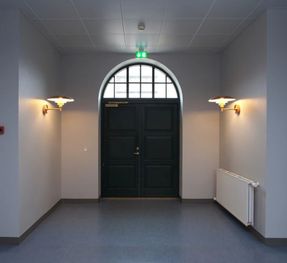
Louis Poulsen PH Wall Lamp
PH WALL LAMP
PH WALL LAMP
Desgined by Poul Henningsen
The fixture is designed based on the principle of a reflective three-shade system, which directs the light downwards.
The shades have a matt white painted inside to ensure diffused, comfortable light distribution.
INFORMATION
WEIGHT
Max. 6.8 kg
LIGHT SOURCE
Light source 1x100W E27
MOUNTING
-Terminal Block : 1x3x2.5mm². -Looping : Approved, max. 3x1,5mm². -Cable entries : 2x bottom + 2x rear entries for Ø 10-14.5mm cable or 2x rear entries for Ø 10-14.5mm cable.
ENVIRONMENTAL SPECIFICATION
This product is compliant with the requirements contained in the European Directives, RoHS Directive 2011/65 and 2015/863. This product is designed so that 100% of the product can be disassembled and reused.
BUG RATING
B0 U1 G0
FINISH
Brushed Copper
CLASS
Ingress protection IP23. Electric shock protection I w. ground.
DESIGN TO SHAPE LIGHT
Louis Poulsen has always sought, not only to design lamps, but also to shape light and create an atmosphere that makes people feel good, both in- and outdoors. The shape of light creates space and our products should live harmoniously within the space they define - indirect, soft and inviting.
PRODUCT TYPE
Wall lamp
DESIGNER
Poul Henningsen
PRODUCTION
Made in Denmark
BRAND
Louis Poulsen
LIGHT DESCRIPTION
Primarily directs light down Optional top and bottom glare shields of translucent white acrylic available.
SPECIFICATION
The innovation of light sources is ongoing. Consequently we only inform about the max. wattages. On www.louispoulsen.com we update a list of recommendable light sources.
DESIGNER - POUL HENNINGSEN
Poul Henningsen was born in Copenhagen by the famous Danish writer Agnes Henningsen. He never graduated as an architect, but studied at The Technical School at Frederiksberg, Denmark from 1911-14, and then at Technical College in Copenhagen from 1914-17. He started practicing traditional functionalistic architecture, but over the years his professional interests changed to focus mainly on lighting which is what he is most famous for.
STORY
THE STORY BEHIND THE PRODUCT
Poul Henningsen designed the three-shade system back in 1925-1926.
The first lights using the system were designed by PH in cooperation with Louis Poulsen for an exhibition in Paris. This partnership continued up until his death in 1967. Throughout his life, PH sought to create glare-free light, direct light where it was most needed, and create soft shadows, using incandescent bulbs as a light source.
PH Wall is a member of the three-shade family which numbers 30 lights today, including three for outdoor use. Thus PH did not just design a light, but an entire system – around a thousand different models have been produced over the years. This wide selection consisted of table, floor and wall lamps, as well as a number of different chandeliers, which were very popular in the 30s for lighting private homes from high ceilings.
There were countless combination options. The lights were available in different colours, as well as a range of sizes.
The first shades were made of metal with a painted undersurface, such as white, gold or silver – depending on whether diffuse, warm or cold light was desired.
Glass was later introduced for the three-shade system. In addition to the downward-directed light, glass lamps illuminated the room. PH was the first person to pursue a scientific approach to light and use the logarithmic spiral as a basis. By using a design based on the logarithmic spiral he achieved even distribution of light over the entire curve of the shade. This even light distribution, together with the diffuse reflection through the glass, made it possible to control glare and shadow.
Each shade reduces the amount of light equally, due to their distance from the light source. The PH light model numbers refer to the shade size. Each top shade had a corresponding set of middle and lower shades. In the ‘pure’ models, such as the 2/2, the top shade has a size of about 20 cm, with corresponding lower shades. PH Wall consists of an approximately 45 cm top shade, but uses lower shades from the 3/3 model.
These ‘hybrid’ models were introduced due to the desire to hang pendants at lower heights. The system was also used for wall, floor and table lamps. PH Wall was launched in 1966.








